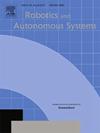基于鲁棒模型预测控制的分布式协同追击包围圈保证
IF 4.3
2区 计算机科学
Q1 AUTOMATION & CONTROL SYSTEMS
引用次数: 0
摘要
本文研究了一个具有包围保证的合作追逃问题。受到在监视等实际应用中对逃避者形成包围圈的重要性的启发,我们在综合合作追击策略时明确考虑了整个游戏中的包围圈条件。与传统的追捕逃避问题不同,所研究的问题需要在捕获和包围条件之间进行仔细的平衡。为了解决这一具有挑战性的问题,我们利用包围条件的几何性质,开发了一种基于鲁棒模型预测控制(RMPC)的策略,以共同考虑包围和捕获需求。为了解决集中式RMPC问题的双线性性,并尊重通信约束,我们提出了一种新的方法来解耦追踪者之间的追踪-逃避问题。这种分布式策略依赖于一种新的包围保证扇区集(EGSS)概念,该概念用一组解耦的线性RMPC问题向原双线性RMPC问题内逼近。这些线性问题可以通过仅使用局部信息的管模型预测控制(TMPC)有效地解决。为了验证所提出的框架的有效性,我们提供了广泛的仿真实验与现实的移动机器人模型。与基于voronoi的基线策略的比较证明了所提出的方法在保证包围的同时实现成功捕获的鲁棒性。本文章由计算机程序翻译,如有差异,请以英文原文为准。
Distributed cooperative pursuit with encirclement guarantee via robust model predictive control
This paper studies a cooperative pursuit-evasion problem with the encirclement guarantee. Inspired by the importance of forming an encirclement of the evader in practical applications such as surveillance, we explicitly consider the encirclement condition throughout the game in the synthesis of a cooperative pursuit strategy. Different from classical pursuit-evasion problems, the studied problem requires a careful balance between the capture and encirclement conditions. To solve this challenging problem, we exploit the geometric nature of the encirclement condition and develop a robust model predictive control (RMPC) based strategy to account for the encirclement and capture requirements jointly. To address the bilinearity of the centralized RMPC problem and to respect the communication constraint, we proposed a novel approach to decouple the pursuit-evasion problem among the pursuers. Such a distributed strategy relies on a novel Encirclement-Guaranteed Sectors Set (EGSS) concept that inner-approximates the original bilinear RMPC problem with a set of decoupled linear RMPC problems. These linear problems can be efficiently solved by Tube Model Predictive Control (TMPC) with only local information. To validate the effectiveness of the proposed framework, we provide extensive simulation experiments with realistic mobile robot models. Comparisons with the baseline Voronoi-based strategy demonstrate the robustness of the proposed approach in guaranteeing encirclement while achieving successful capture.
求助全文
通过发布文献求助,成功后即可免费获取论文全文。
去求助
来源期刊

Robotics and Autonomous Systems
工程技术-机器人学
CiteScore
9.00
自引率
7.00%
发文量
164
审稿时长
4.5 months
期刊介绍:
Robotics and Autonomous Systems will carry articles describing fundamental developments in the field of robotics, with special emphasis on autonomous systems. An important goal of this journal is to extend the state of the art in both symbolic and sensory based robot control and learning in the context of autonomous systems.
Robotics and Autonomous Systems will carry articles on the theoretical, computational and experimental aspects of autonomous systems, or modules of such systems.
 求助内容:
求助内容: 应助结果提醒方式:
应助结果提醒方式:


